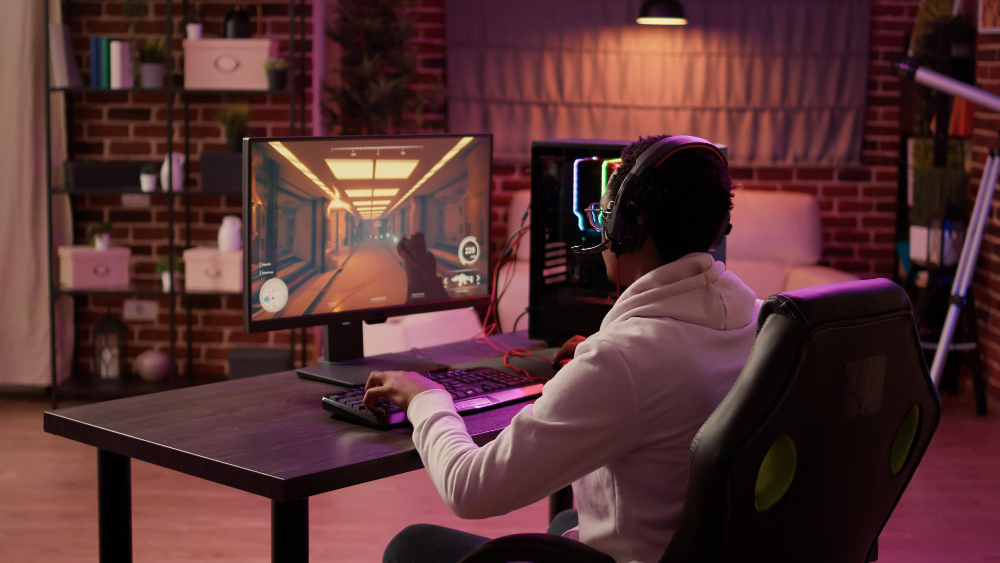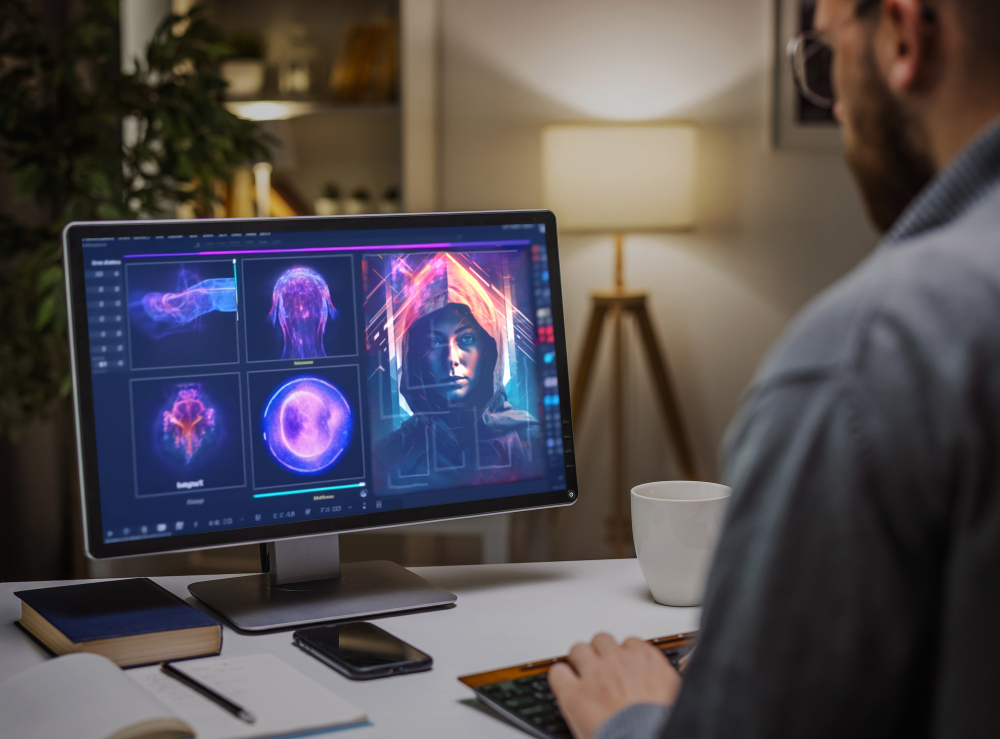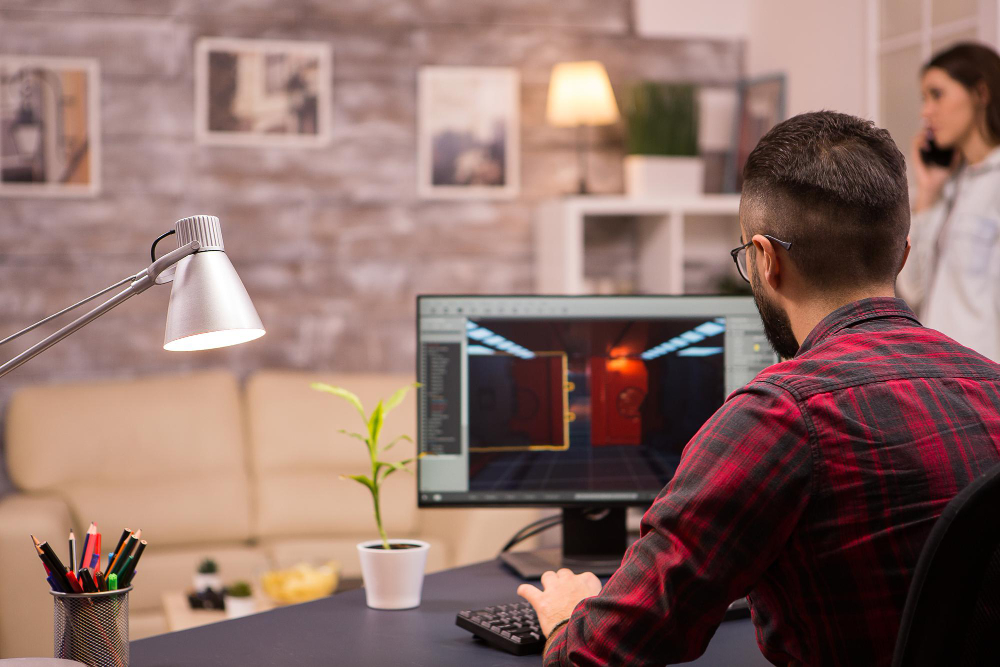Game modeling serves as the cornerstone of contemporary game development, the driving force behind the creation of games that transport players to fantastical worlds and gripping adventures. From the towering skyscrapers of futuristic cityscapes to the complex and intricate details of a hero’s armor, every aspect of the gaming experience is created through the art and science of game 3D modeling.
In this comprehensive guide, we will closely look at 3D modeling for games, shedding light on its vital role in shaping the landscapes, characters, and narratives that define the gaming landscape.
3D Modeling in Games:
At the heart of game modeling lies 3D and modeling process, a versatile process important to build game assets and characters that define modern gaming industry. Using advanced software and techniques, game developers sculpt complex 3D models and game props. This process enhances the visuals of game elements and allows for simulations and effects as per game’s requirements.
But 3D modeling’s impact goes beyond visuals. It empowers creative freedom, allowing designers to craft diverse characters, environments, and objects, each with its unique style and personality. From the imposing giants of fantasy RPGs to the whimsical creatures of platformers, each meticulously crafted model contributes to the world-building, immersing players in captivating narratives and unforgettable experiences.
In addition to enhancing visuals and enabling dynamic elements, 3D modeling in mobile or pc games offers creative freedom. Artists and game designers can utilize various techniques in game creation, from organic modeling and character modeling for games, to digital sculpting of game environments. With each meticulously crafted model, the immersive worlds of gaming are enriched, captivating players’ imaginations and ensuring unforgettable gaming experiences.
Why Game Developers Need 3D Modeling?
Game developers rely on 3D modeling for several crucial reasons that enhance both the quality and depth of their creations.
Firstly, 3D modeling for games, allows developers to bring their creative visions to life. By detailed character modeling, game environments, and objects, developers can construct a virtual world that increases player engagement and draw them into the gaming experience.
Additionally, 3D modeling facilitates the creation of visually stunning graphics that elevate the overall quality of the game. Detailed 3d models and textures contribute to realism in game design, allowing players become fully immersed in the virtual environment.
Moreover, 3D modeling for games enables developers to implement dynamic elements with as much detail, such as physics-based interactions and realistic animations. This adds depth and complexity to gameplay mechanics, enhancing the overall player experience and providing opportunities for innovative and engaging gameplay.
Overall, 3D modeling plays a significant role for game developers, enabling them to unleash their creativity, enhance visual appeal, and create games that captivate players worldwide.

Use of 3D modeling in Virtual Reality Games :
The advent of virtual reality (VR) has brought a new era for the gaming industry. In this kind of games, 3D modeling becomes important in enabling developers to create virtual environments. Concept artists use 3D modeling software and tools, building different kinds of games from first person shooter games to RPGs.
Moreover, 3D modeling plays a pivotal role in shaping the characters and avatars that populate the VR games. Through intricate 3D modeling techniques and advanced texturing, developers can create lifelike avatars that respond to players’ movements and interactions, further enhancing the sense of immersion. Whether assuming the role of a brave hero, a cunning rogue, or an otherworldly being, players can inhabit these digital personas and navigate VR landscapes with unprecedented agency and realism. Thus, the collaboration of 3D modeling and virtual reality technology empowers developers to experiment more with games and smoothen the entire process.
The Process of Game Modeling for Game Development
Game 3d models are the key to the digital worlds we explore, but how does a character, prop, or environment go from a mere idea or concept art to a functioning asset within a game? Let’s explore the detailed process of game 3D modeling, breaking it down into key stages with more specific explanations and considerations:
1. Pre-Production
The pre-production phase is crucial for 3D modeling for games. This phase is about defining the purpose of 3D modeling and choosing the required game engines and tools.
Is it a playable character, a background object, or a key narrative element? Understanding its role shapes the level of detail and animation complexity required. Moreover, Are you aiming for photorealism, a stylized look, or a specific artistic direction? Consider the target gaming platform, and hardware limitations to ensure the smooth 3D character modeling for games.
Collect visual reference concept art, sketches, photographs, or even 3D models or scans of similar objects or characters for 3D modeling. Use these references to inspire your design and ensure visual consistency. Additionally, choose a 3D modeling software at this stage. Popular options include Blender, Maya, ZBrush, 3ds Max, and Modo. Each offers different strengths and specializations. Consider factors like personal preference, project requirements, and budget. If creating animated characters, you’ll need software like Maya, Blender’s rigging tools, or dedicated animation software. Additionally, there are other tools that offer different approaches to texturing and material creation. Choose based on your workflow and desired level of detail. Nowadays, there are many online 3D modeling for games tools which are extremely cost effective
2. Modeling:
The second stage of the 3D modeling for games process involves working on the models. Here, you will have to make decisions about what kind of model you are creating.
For Low-Poly Models, focus on efficient topology. Create a clean and optimized mesh with low to high polygon count each, using techniques like quads and triangles. This ensures smooth performance in-game, especially for characters and complex objects. Additionally, capture the overall shape and proportions of the model accurately. Create simplified versions of the model for different viewing distances (e.g., far away vs. close-up) to further optimize performance.
In case of High-Poly Modeling add detail and definition. Use sculpting tools or retopology techniques to add wrinkles, folds, textures, and other details. This enhances the visual fidelity for close-up views and cinematics. While adding detail, ensure the mesh remains efficient and avoids unnecessary complexity. Balanced detail and performance are crucial.
3. Texturing and Materials:
The third stage of 3D modeling for games involves UV wrapping and creating textures.
Unwrap the 3D model onto a 2D texture map. Different unwrapping techniques (e.g., automatic vs. manual) exist in 3D modeling, affecting texture efficiency and detail control. Aim for minimal stretching and distortion in the unwrapped texture map to ensure textures appear correctly on the model.
To create textures, choose a texturing approach. Hand-painting in Photoshop or Substance Painter, procedural texturing tools, or even AI-based methods are available. Each offers different levels of control and detail. Define surface properties like roughness, reflectivity, and emissivity to create realistic or stylized materials. Additionally, use features like PBR (Physically Based Rendering) materials and procedural textures for realistic and efficient results.
To transfer details from high-poly to low-poly use baking techniques to bake lighting, shadows, and details from the high-poly model onto the optimized low-poly model. This preserves visual quality while maintaining performance.
4. Rigging and Animation (for Characters and Moving Objects):
At this stage of 3D modeling, you will focus on bringing inanimate characters to life for games.
First comes rigging, where a virtual skeleton of interconnected bones and joints is built within the model. This structure needs to consider the character’s movements and expressions. Weight painting then defines how each bone influences the mesh, creating smooth movement and believable interactions. Advanced techniques like inverse kinematics for complex motions and blend shapes for facial expressions further enhance realism.
Through keyframes placed within animation tools, you can pose and animate the model, bringing its personality and actions to life. For added realism, you can use motion capture technology to translate real-world movements onto the digital character, resulting in lifelike animations.
5. Optimization and Export:
After crafting the character’s life through animation, the final step of 3D modeling is ensuring its smooth integration into the game environment.
Optimization plays a crucial role here, reducing the model’s complexity without sacrificing quality. This starts with analyzing the polygon count, strategically simplifying less detailed areas while maintaining high detail where needed. Tools like decimation and retopology offer further optimization.
Textures also require attention. Lowering resolution without losing quality and utilizing texture atlases to combine multiple textures into one both improve performance and minimize draw calls. Finally, implementing multiple levels of detail (LODs) for characters and objects based on viewing distance ensures smooth performance across various scenarios.
Exporting the final masterpiece for use in your game engine is the last hurdle. Choosing the correct format, like FBX or OBJ ensures compatibility with your engine. Additionally, exporting with the right settings, specifying details guarantees proper import and rendering within games. With these final steps, your 3D modeling is ready to shine in its digital world.

Trends and Innovations in Game 3D Modeling
The world of game modeling is constantly evolving, pushing the boundaries of creativity and technical prowess. Let’s look into this exciting field of 3D modeling, exploring trends and emerging techniques that are transforming how we build the a virtual world for games.
Current Trends Shaping Game Modeling Practices:
Let’s look at the current trends of 3D modeling for games:
Storytelling through Detail:
3D modeling is an integral tool for narrative expression in games. Subtle details put into environments and character modeling make the games vibrant. Imagine worn out walls hinting at past conflicts or a character’s clothing subtly revealing their social status. These details silently speak volumes, giving the players a rich experience.
Procedural Generation Takes the Stage:
Technology is stepping in to generate unique assets like textures, environments, and even characters. This procedural modeling allows for vast, dynamic worlds while saving precious development time. Landscapes with diverse ecosystems or towns bustling with unique NPCs, all brought to life through algorithmic magic spells.
The Spectrum of Styles:
Both ends of the visual spectrum are trending in 3D modeling for games now. High-fidelity models push the boundaries of realism, creating characters and environments so detailed they blur the lines with augmented reality too. On the other hand, stylized models embrace artistic expression, defining games with distinct visual identities.
Adapting to Every Platform:
With games accessible across devices, 3D models need to be adaptable. Optimizing for mobile games’ varying performance demands is crucial. Seamless integration of 3D models from high-fidelity detail on a powerful PC to a stylized, optimized version on a mobile device, can ensure that games are an enjoyable experience for all players.
Technological Advancements and their Impact:
The world of 3D modeling for game design is constantly evolving, fueled by exciting technological advancements. Today, artists have powerful tools at their disposal to focus on the technical aspects of the modeling process.
Real-time rendering engines
These engines are paving the way for stunning visuals without sacrificing performance. This allows for more immersive games, where complex details and lighting effects are infused. Additionally, cloud-based tools are building collaboration and streamlining workflows. Sculptors can work together in real-time, receiving instant feedback and iterating on designs more efficiently.
AI-assisted workflows
are automating tedious tasks like retopology and texture generation. This speeds up the process for the artists as well as game developers. Meanwhile, VR and AR integration in games opens up exciting possibilities for modeling immersive experiences. Understanding how the 3D models translate to these different platforms and optimizing them for interaction is a crucial skill for future-proof artists.
3D scanning and photogrammetry
bridge the gap between the real and virtual worlds in many games. By seamlessly integrating real-world objects into virtual environments, these technologies enhance authenticity and detail, adding a layer of realism that players can truly connect with.
Behind every successful game lies a powerful game engine, providing the framework for developers to bring their visions to life. The game engines offer robust tools for game modeling, rendering, and animation. Additionally, specialized modeling software such as Blender and Maya empower artists to create stunning visuals and seamless integrations within the game world.
Emerging Techniques and Tools:
Procedural animation brings characters to life in a whole new way. Animations no longer need to be pre-recorded; instead, they adapt to player actions and environments, creating dynamic and responsive interactions.
Artistic expression flourishes with non-photorealistic rendering (NPR). Advanced rendering techniques open doors to stylized visuals, allowing artists to explore unique aesthetics previously limited by traditional methods. Node-based texturing simplifies the creation of complex materials and textures. Gone are the days of meticulously hand-painting every detail. Instead, artists connect nodes representing various properties like color, roughness, and metallics, creating intricate textures intuitively and efficiently. This not only saves time but also allows for easier experimentation and fine-tuning.
Generative adversarial networks (GANs) leverage machine learning to produce unique and high-quality textures and even detailed models, based on provided inputs. While still in its early stages, GAN technology holds immense potential for streamlining workflows and unleashing artistic creativity.
Open-source tools and communities are democratizing game development and fostering innovation. These open-source platforms foster collaboration and knowledge sharing, accelerating the pace of innovation and enabling anyone with passion to contribute to the world of game modeling.
Career Opportunities:
As the gaming industry explodes, skilled game modelers remain hot property. From bustling studios to daring indie developers, diverse opportunities await artists and developers eager to make their mark. By staying at the forefront of technology and meticulously honing their skills, aspiring game modelers can carve out fulfilling careers in this dynamic field.
In studios, character artists focus on character modeling, crafting detailed 3D models that capture individuality, emotion, and movement. Environment artists build the immersive backdrops of game worlds, crafting landscapes, cityscapes, or intricate interiors that captivate players. Technical artists bridge the gap between art and engineering, optimizing models for performance without sacrificing visual quality. Finally, 3D props artists design and model the diverse objects that populate the game world, from weapons and tools to furniture and vegetation. Attention to detail, prop design understanding, and versatility are key to bringing these objects to life.
Beyond the studio walls, freelance modelers and outsourcing team operate independently, taking on projects from various studios or individual clients. In indie game development, artists join or lead independent teams, wearing multiple hats and contributing their modeling expertise to bring unique game concepts to life.
Finally, some choose to share their knowledge by teaching both game development and modeling at universities, art schools, or online gaming platforms themselves. Expertise, communication skills, and a passion for nurturing future generations of artists are their valuable assets.
Future Outlook:
3D modeling in games is poised for a major leap forward, driven by advancements in technology and AI. Future tools could automate tedious tasks like rigging and weight painting, saving time and effort for creators. Procedural generation techniques could streamline the creation of vast, realistic environments, reducing manual work needed for textures and vegetation. Additionally, real-time ray tracing and photogrammetry will push graphical fidelity to new heights.
Beyond visuals, democratization of tools and resources will open doors for a wider range of creators, fostering diverse art styles and perspectives. Cloud-based collaboration platforms will enable seamless teamwork across geographical boundaries. Procedural modeling and machine learning could even allow players to influence character behavior and appearance, blurring the lines between player and participant. The future of 3D modeling in games is not just about creating stunning graphics; it’s about building truly immersive gaming experience that empower players like never before.
Bonus Tips for Game Modeling:
Here are some bonus tips to propel your skills of 3D modeling for games to the next level:
1. Become a Master of Storytelling:
Game models are not just polygons and textures; they are crucial storytelling elements. Imbue your characters and environments with subtle details that tell a story. Imagine a weathered sword hinting at a character’s past battles or a bustling marketplace showcasing the cultural diversity of a game world. These details breathe life into your creations and enrich the player’s experience.
2. Master the Art of Collaboration:
Game development is a collaborative effort. Learn to communicate effectively with designers, programmers, and animators. Understand their needs and tailor your models accordingly. This collaborative spirit fosters a stronger final product and makes you a valuable asset to any team.
3. Don’t Neglect the Power of Feedback:
Finally, share your work with peers, online communities, and even potential employers. Seek constructive feedback and actively learn from it. Criticism can be challenging, but it’s a crucial tool for growth and improvement.

Conclusion:
In conclusion, game 3D modeling stands as the bedrock of modern games and the gaming industry, offering a gateway to immersive virtual worlds and captivating experiences. From the meticulous crafting of characters and environments to the innovative techniques bringing in advancements, game 3D modeling shapes the future of gaming. As the industry evolves, opportunities abound for skilled artists and developers to leave their mark, whether in big studios, indie projects, or the growing world of freelance work. With creativity, expertise, and a passion for pushing boundaries, game modelers continue to redefine the landscape of interactive entertainment, ushering in a new era of gaming experiences for players worldwide.
Get your hands on 3D modeling with 3DAiLY today.



